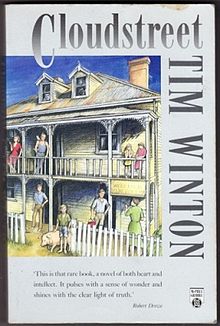 One of my favourite examples of “showing” is from Australian writer Tim Winton. In the following example from Cloudstreet, Lester Lamb and his sons, Quick and Fish, are netting for prawns, walking out into the water from the beach carrying the heavy nets. (This is Telling).
One of my favourite examples of “showing” is from Australian writer Tim Winton. In the following example from Cloudstreet, Lester Lamb and his sons, Quick and Fish, are netting for prawns, walking out into the water from the beach carrying the heavy nets. (This is Telling).
In the following example, showing depends on the choice of words, active verbs, the clever use of punctuation, the short sentences, use of dialogue, choice of a scene about a near drowning, the voice. In other words, everything at the writer’s disposal.
And Lester Lamb, turning in alarm at the shout from the shore, came round too hard and swung the lamp into the water and left them in hissing darkness. Quick was yelling; he heard the boy beating the water.
Quick staggered and fell over the net and squealed at himself trying to get off, to get it off. A pole glanced off his chin. He felt the net butt under him. Fish! He was on him; he was trying to come up under the net.
Lester Lamb hoisted Quick out of the water and off the net. The sky was the colour of darkness, starless, mute. Everywhere, everything was net.
He’s under it, get it off get it off! Quick was yelling.
Lester Lamb could not see. He could only feel water and net and panic. (page 39)
Omniscient narration (read possibly “old-fashioned writing”) is no longer widely practised by the modern fiction writer. Of course, showing is not the only method of creative writing, and all showing would be just as cumbersome and annoying as all telling, even for a modern reader. And a writer who eschews prescriptive writing of all types, and prefers to experiment with form, might decide to avoid showing and to follow a more unique path, which might include the use of telling.
To sum up, in fiction, it’s all about utilising both, showing and telling in combination, with the latter employed more sparingly.

Leave a Reply
You must be logged in to post a comment.